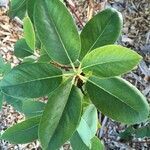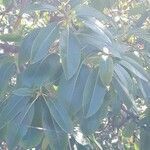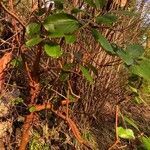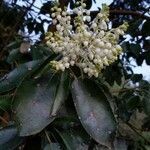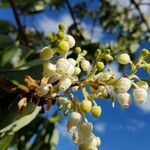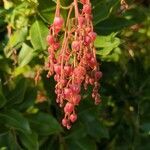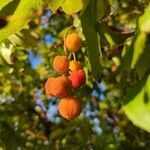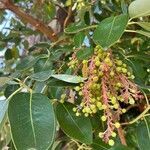Shrubs or trees, 4-10(-20) m; bark dark red, smooth, until mid season when outer bark exfoliates, inner bark green, soon weathering to dark red; following exfoliation on younger wood, bark retained on oldest portions of main axis and on abaxial sides of larger lateral axes, area of retained bark gradually increasing as tree ages, becoming roughened dark gray. Leaves larger on sterile shoots with longer internodes; petiole 2-4.5 cm, base slightly decurrent, glabrous, sometimes with hairs adaxially; blade glaucous-green abaxially, olive-green adaxially (leaves of previous season turning yellow and red in June and July before they fall), elliptic, 6.5-13 × 3.5-6(-8) cm, base usually rounded, sometimes slightly cordate, rarely tapered, apex usually rounded or acute, rarely with short cusp, surfaces glabrescent (sparingly hairy on newly emerging leaves). Inflorescences (often compound), congested or not; axes hairy ± throughout, hairs not glandular. Pedicels accrescent, initially pendulous, becoming stiffly erect, 3-5(-6.2) mm, (to 6-8 mm in fruit), sometimes sparsely glandular-hairy; bract clasping base, rust-colored, scalelike, 2-3.5 mm. Flowers: calyx creamy tan at anthesis, lobes 1-2.1 mm, apex blunt; corolla 4.9-5.8 mm; anthers 1-1.2 mm, spurs usually slightly exceeding length of thecae; ovary with 2-5 ovules per locule. Berries red or orange-red, 13-20 mm diam. Seeds 2-2.5 mm.
More
An evergreen tree. It can grow to 20-30 m high. The trunk is 60-100 cm across. It has smooth reddish-brown bark. This peels off in papery flakes. The freshly exposed bark is green. The leaves are oval and 7-12 cm long. The leaves have smooth edges and are glossy green. They are whitish underneath. The male and female flowers are yellow and bell shaped and born on separate trees. The flowers occur in large clusters. They are white. They have a strong honey odour. The fruit are small and orange-red. They are 1 cm across. They have a grainy surface and many seeds.
Can be grown by cuttings or seedlings. Seeds needs soaking and stratification.
